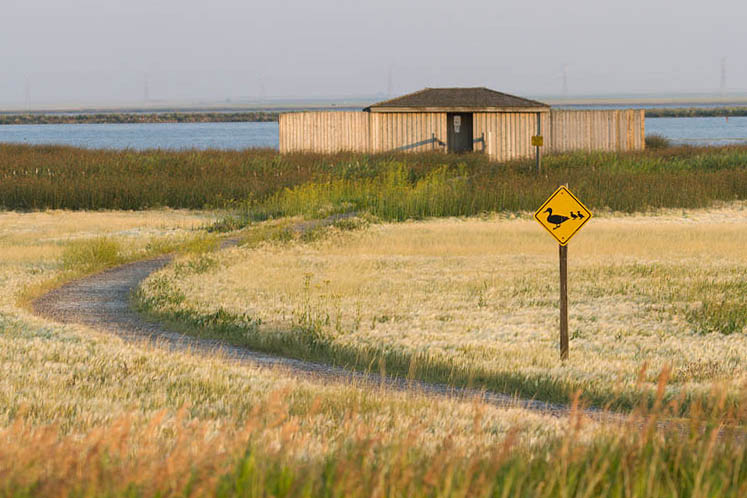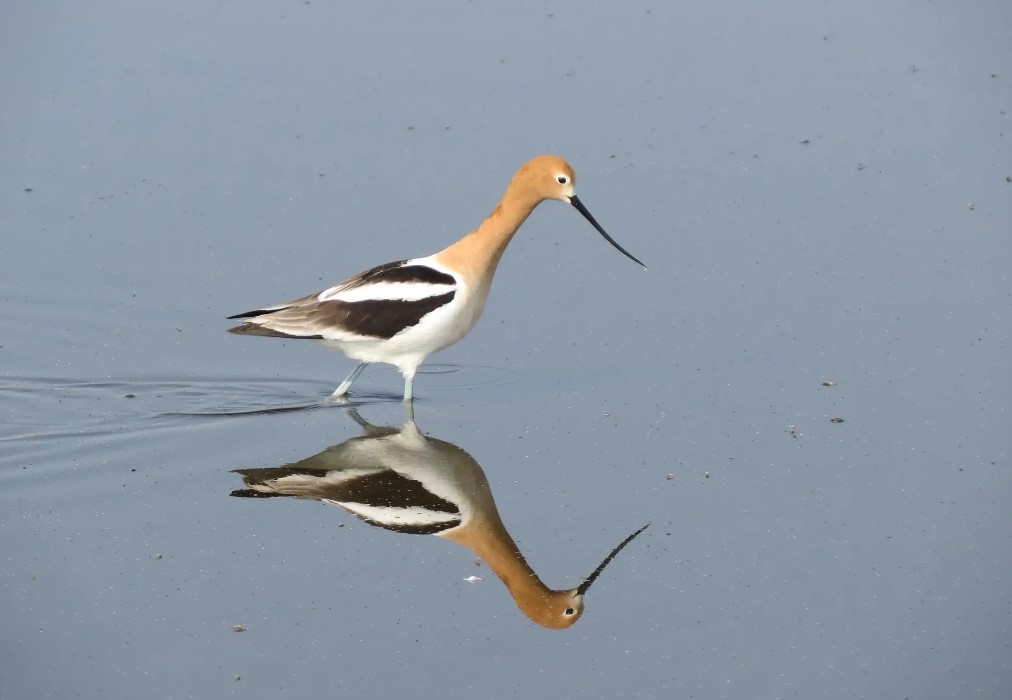
By Amanda Bichel, Key Biodiversity Areas Coordinator, Birds Canada
Frank Lake is a beautiful place, plain and simple. It’s also the most important wetland for birds in southwestern Alberta. Through the work I do with Birds Canada and our supporters, helping to identify the most important sites for birds and other species across Canada, I’ve learned from the data what makes this such a special place. And, earlier this year I had the chance to experience it for myself and see how a proposed solar development would change its landscape and impact wildlife.

Frank Lake is large but shallow, and offers a range of features beneficial to birds: a guaranteed supply of water, large beds of emergent vegetation like Cattails, open shoreline, and important surrounding habitat including quasi-native grasslands, tame pastures, and cultivated fields that provide feeding areas for waterfowl, cranes, and blackbirds. At times, large mudflats are exposed as well, giving many shorebirds a place to forage. Frank Lake has recently been recognized as a Key Biodiversity Area (KBA), which means it is a critical place for nature based on a set of criteria that is globally accepted. Similarly, it has been an Important Bird and Biodiversity Area (IBA) for 20 years. These designations are easy to quantify, and thanks to local monitoring efforts, show that Frank Lake supports significant numbers (more than 1% of their global or national population) of birds. This includes migrating shorebirds and waterfowl, such as Trumpeter and Tundra Swans; breeding waterbirds, like Franklin’s Gulls; and certain species at risk, like Bank Swallows. Furthermore, grassland birds and aerial insectivores – bird groups that have been declining rapidly – and 60 sensitive or at-risk bird species use the site.

In September, I met up with the volunteer Caretaker for the Frank Lake KBA, Greg Wagner. Caretakers are local, on-the-ground stewards and the heroes of the IBA/KBA program. Greg has been a dedicated Caretaker for over a decade, and has visited the area since he was young. As Caretaker, he’s been monitoring and reporting bird numbers in every season, watching for population trends, and also keeping an eye on the sight for any threats the area might face. Nobody knows more about this site than Greg, and he showed me that first hand with his expert tour, at no charge (I did drive my tiny car down the tall grassy backroads at Frank Lake, so it evened out). Greg stressed that without intervention from Ducks Unlimited Canada who manage the lake, it would have been drained long ago, and not exist now.

The first stop we made on the way to the proposed solar farm site was on the highway, where we had quasi-native prairie on either side of us, still in the IBA boundary. We talked about how water flows from spring melt through ephemeral creeks into Frank Lake, and how there are natural drought and wet cycles for Frank Lake. At one point, the lake bed was so dry that there was a landing strip on it! Next, we drove down a public road that is well hidden and infrequently visited: a great spot to bird alone. From here you can sometimes see up to 5000 swans, about two-thirds of them Trumpeter Swans (a bird still recovering from overhunting), and a few rare grassland birds like Baird’s Sparrow and Sprague’s Pipit. This spot is managed by Ducks Unlimited who allow grazing every three to four years by cows and goats, to keep weeds and grass at optimal density for nesting birds. This is a great example of how the community works with conservation organizations for the benefit of nature.
We saw 140 Greater White-fronted Geese in the field – an exceptional sighting – on the way to our next stop in the middle of the proposed solar farm site. One day, solar panels might encroach into the northern part of the Frank Lake KBA boundary. To either side was cultivated land, so at least rare prairie grassland habitat is not under threat. However, these fields can have 10,000 pintails in certain years, as well as swans, Snow Geese, blackbirds, and more. In the fields, there are also small prairie potholes that the solar farm would surround. These seasonal wetlands are important for shorebirds and waterbirds, especially in wet years.

Foothills Solar Project, proposed by Elemental Energy, would cover 1500 acres of farmland. Solar is a renewable energy source, and is a great step in reducing our dependence on fossil fuels – but, there are alternative places for these developments, where they don’t strain the ecosystems we are trying to protect. A place where tens of thousands of birds migrate past, and, just a kilometre away, land on water, is not an appropriate place. Birds like coots (which were there in the thousands the day I visited), grebes, and loons, can’t take off without water. Solar panels can appear as water to birds flying overhead, known as “lake effect”. These birds could land and have no way to take off, which can lead to their death. Insects, an important food source for many birds, can also confuse the panels for water, landing on them to lay eggs, where there is no water for the eggs to survive.

This would be the first solar farm close to a site with so much diversity, and so many congregating birds that depend on the lake during breeding and migration. In fact, Alberta best management practices state that a solar energy project should not occur within 1000 m of a wetland-based IBA. Birds Canada strongly supports this recommendation of keeping development that is harmful to birds and ecosystems out of KBAs and away from their boundaries. This project would be built on portions of five sections of land. Two of the sections are in the IBA, and about half of the remaining portion of the project is within a kilometre of the boundary. Based on mortality rates observed at other solar facilities, hundreds of birds could die annually at the proposed solar project. Why would we risk testing that on one of the most important wetlands in southwestern Alberta?
There are additional benefits to keeping the Frank Lake KBA intact. Frank Lake is recognized as one of the most popular birding spots in the Canadian Prairies. People from all over the world visit Frank Lake, and in the spring there can be 500-600 people per day birding there. This is good for the economy and to spread awareness about birds and conservation in general. Furthermore, Frank Lake is a conservation area that has been managed by Ducks Unlimited since the 1990s. This has taken extensive planning, now that land is at least five times pricier than it was then, this project and habitat are irreplaceable in southern Alberta.

Many local residents from High River, Blackie, and surrounding areas, oppose the development of this solar farm. The Alberta Utilities Commission is currently reviewing the project. Local residents have recruited a lawyer to represent them at the review hearing. If you share our concerns about the location of this solar farm and its impacts on birds, we encourage you to sign the petition on change.org; send a letter to the Alberta Utilities Commission; the Alberta Minister of Environment and Protected Areas; and/or the Federal Minister of Environment and Climate Change; as well as share media like this blog post.